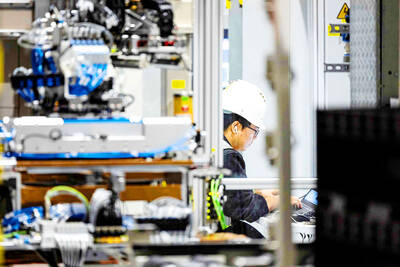Thailand faces a shortage of about 500,000 foreign workers in its manufacturing and services sectors to support an economic recovery from the COVID-19 pandemic, with the government having lifted almost all virus-related travel and business restrictions
A combination of factors including civil strife in Myanmar and virus outbreaks in neighboring countries has led to fewer-than-expected people seeking work in Thailand.
Meanwhile, demand for staff is growing, especially in tourism-related sectors as well as labor-intensive industries like construction and fisheries, where Thais reject jobs because of low pay and difficult work conditions.

Photo: AFP
“This is a serious problem, as Thailand needs these foreign workers to help drive the economy,” said Poj Aramwattananont, vice chairman of the Thai Chamber of Commerce. “We will need more workers going forward, because we have lots of major infrastructure projects. We also have many services-sector jobs that need to be filled.”
Southeast Asia’s second-largest economy is on a recovery path after enduring its steepest contraction in more than two decades in 2020. More than 300,000 foreign workers were estimated to have left Thailand since the pandemic started, with only about 20,000 having returned this year under the bilateral contracts between Thailand and some peers in ASEAN.
About 2.5 million foreign workers are estimated to live in Thailand, Department of Employment Director-General Piroj Chotikasatien said.
The government recently changed rules to enable people with Laos, Myanmar, Vietnam and Cambodia nationalities who are working illegally in Thailand to register and gain a pathway into the formal system.
It also extended the expiring work permits for about 1.7 million people through 2025.
As many as 500 people from neighboring countries are crossing borders every day to seek work in Thailand.
That number would soon increase to 2,000 per day, the Department of Employment has said.

CHIP RACE: Three years of overbroad export controls drove foreign competitors to pursue their own AI chips, and ‘cost US taxpayers billions of dollars,’ Nvidia said China has figured out the US strategy for allowing it to buy Nvidia Corp’s H200s and is rejecting the artificial intelligence (AI) chip in favor of domestically developed semiconductors, White House AI adviser David Sacks said, citing news reports. US President Donald Trump on Monday said that he would allow shipments of Nvidia’s H200 chips to China, part of an administration effort backed by Sacks to challenge Chinese tech champions such as Huawei Technologies Co (華為) by bringing US competition to their home market. On Friday, Sacks signaled that he was uncertain about whether that approach would work. “They’re rejecting our chips,” Sacks

It is challenging to build infrastructure in much of Europe. Constrained budgets and polarized politics tend to undermine long-term projects, forcing officials to react to emergencies rather than plan for the future. Not in Austria. Today, the country is to officially open its Koralmbahn tunnel, the 5.9 billion euro (US$6.9 billion) centerpiece of a groundbreaking new railway that will eventually run from Poland’s Baltic coast to the Adriatic Sea, transforming travel within Austria and positioning the Alpine nation at the forefront of logistics in Europe. “It is Austria’s biggest socio-economic experiment in over a century,” said Eric Kirschner, an economist at Graz-based Joanneum

BUBBLE? Only a handful of companies are seeing rapid revenue growth and higher valuations, and it is not enough to call the AI trend a transformation, an analyst said Artificial intelligence (AI) is entering a more challenging phase next year as companies move beyond experimentation and begin demanding clear financial returns from a technology that has delivered big gains to only a small group of early adopters, PricewaterhouseCoopers (PwC) Taiwan said yesterday. Most organizations have been able to justify AI investments through cost recovery or modest efficiency gains, but few have achieved meaningful revenue growth or long-term competitive advantage, the consultancy said in its 2026 AI Business Predictions report. This growing performance gap is forcing executives to reconsider how AI is deployed across their organizations, it said. “Many companies

France is developing domestic production of electric vehicle (EV) batteries with an eye on industrial independence, but Asian experts are proving key in launching operations. In the Verkor factory outside the northern city of Dunkirk, which was inaugurated on Thursday, foreign specialists, notably from South Korea and Malaysia, are training the local staff. Verkor is the third battery gigafactory to open in northern France in a region that has become known as “Battery Valley.” At the Automotive Energy Supply Corp (AESC) factory near the city of Douai, where production has been under way for several months, Chinese engineers and technicians supervise French recruits. “They